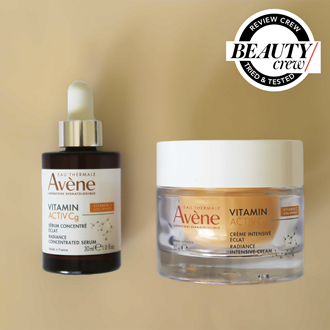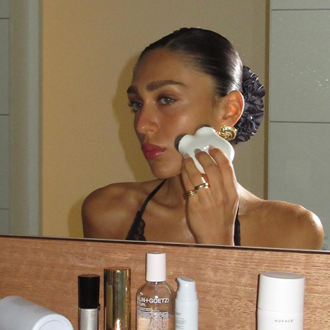Face mapping: Here’s what your pimples are trying to tell you

The technique that’ll help you remain blemish-free
The technique that’ll help you remain blemish-free
Pimples are the worst – always showing up at inconvenient times completely out of nowhere. Or so you might think. As it turns out, there’s nothing random about your breakouts. In fact, your skin could actually be trying to tell you something.
According to traditional Chinese medicine, a weakness or toxicity in a specific organ or gland in the body can result in acne showing up in certain areas of the skin. This theory is called face mapping and it suggests that the location of your acne can actually give you clues about what’s causing it.
Emma Hobson, Education Manager for the International Dermal Institute and Dermalogica, says Chinese face mapping and Dermalogica’s own service, Face Mapping Skin Analysis, are fantastic techniques that are both engaging and informative, “[Face mapping] reviews various aspects of your skin - both skin type and current skin condition. It links this with your current environmental and lifestyle issues such as pollution, UV damage and stress, which for example, may be the trigger for current breakouts or other skin concerns on the skin.”
The technique uses an acne face chart that divides the face into different zones (think of it like a pimple map). Whether it’s cystic acne on the chin, pimples on cheeks or breakouts on your chest, the theory is that where you’re breakout out will help determine the cause and appropriate treatment. “Each zone or area of the face is reviewed using sight and touch to analyse the individual facial landscape,” says Hobson. “Face mapping is quick, only taking around five minutes,” she adds.
According to Hobson, you’ll need to undergo an acne face map analysis every few months due to the fluctuations in your skin health, especially between seasons. An acne map will not only give you a reason behind why you’re getting pimples in a specific area, but will also guide you in using the correct products and treatments for your acne.
“Blending the best from Eastern as well as Western techniques of skin diagnosis, we can ‘read’ the signals that our body communicates via our face and our skin; we are better prepared and armed with the information as to how to best customise and treat our customers by achieving the results they are seeking,” says Hobson of Dermalogica’s own acne mapping service.
“A slight adjustment in your skin care program, diet and lifestyle can make all the difference in how we can bring our body back into harmony and balance."
Here are four common areas you may experience breakouts, and what they are trying to tell you about your health.
Forehead
The likely culprit: Poor diet
If you’re constantly experiencing breakouts on your forehead and temples, Hobson says the cause could relate to your digestive system. “The upper part of the forehead is associated with the bladder, the middle with the stomach digestion, and the lower with the small intestines,” she explains.
This may mean that your body is having a hard time breaking down certain foods. “Possible sensitivity and breakouts on the middle of the forehead, for example, could relate to poor diet and a sluggish digestion, which may be a result of eating too late at night,” she notes.
To help control these breakouts, we suggest reducing the amount of fat in your diet (try to cut down on junk food) and stepping up your water intake to flush out toxins. Try drinking herbal teas that contain bitter herbs (such as dandelion, lemon balm) or taking digestive enzyme supplements before each meal to help your body break down foods.
Chin & neck
The likely culprit: Hormonal stress
Hobson says reoccurring monthly breakouts are often caused by fluctuations in hormones. “Many adult women get breakouts around the time of ovulation, typically a couple weeks before the start of their period and these tend to be localised to the area around the sides of the chin.”
Similarly, continuous breakouts on your neck are often associated with hormonal (adrenal) stress. “These breakouts are most likely due to the surge in luteinizing hormone (LH) that is seen at this time. You may notice that the breakouts occur on opposite sides of the chin each month in unison with the particular ovary that happens to be ovulating.”
While hormonal changes can be unavoidable, one way you can decrease their effect on the skin is by eating foods that help regulate your natural hormonal cycle - think leafy green veggies, avocado, nuts and salmon (stay away from processed foods and dairy). Acupuncture can also help rebalance hormones.
Nose
The likely culprit: Cholesterol or circulation issues
Your nose is connected to your lungs and heart - so, if you’re getting constant breakouts or oiliness in this area, this may mean poor circulation or abnormal blood pressure or cholesterol are to blame. It could also have something to do with your cleansing and exfoliating routine.
To combat these pesky breakouts, first try using a cleanser that contain ingredients such as salicylic acid, niacinamide, charcoal and clays. You could also try double cleansing every night (just check out the whole heap of benefits). If that doesn’t help, see your doctor for a health check-up to rule out cholesterol or circulation issues.
Cheeks
The likely culprit: Pollution, allergies or dental issues
Pimples showing up on your cheeks? Pollution, smoking and allergies will damage this part of the skin and not only result in pimples, but also pigmentation and discolouration. “The upper cheek relates to the lungs; if they are red or irritated you may have or had a recent cold/flu, or have inhaled something disagreeable,” says Hobson. “More long-term lung stress from asthma or someone who smokes could be seen as broken capillaries, poor skin texture, increased sensitivity and the creation of a ‘lung line’ from flaccid skin on either side of the nose to mouth area.”
If you tend to breakout on your lower cheeks, it could be due to dental problems such as tooth decay, gum disease, gingivitis or possibly irritated wisdom teeth. In this case, it may be time to take a trip to the dentist for a check-up.
Similar to how mapping acne on your face can tell you what your pimples mean, if you suffer from breakouts on your back, bum, arms and other areas, a body acne map can help you determine the cause and find a solution to clear your skin.
Where can I get face mapping?
Interested in getting your own face breakout map? Dermalogica offer complimentary face mapping Australia-wide, or you can speak to your dermatologist. Once your pimple face map has been completed, a tailored skin treatment plan can then be designed. “For breakouts, this may include using a peel with salicylic acid, antibacterial ingredients to address the breakouts, and LED blue light to speed up skin healing,” says Hobson. In addition to boosting your skin care routine with the right products, you should see your doctor if more serious health issues appear to be the top culprit behind your persistent acne.
If you’re experiencing a major breakout, check out why it may actually be a good thing. Yes, it’s time to be pro pimple!
Have you ever used a pimple chart? Did it help get you on the path to clearer skin? Let us know in the comment section below.
Main image credit: Getty

Erin Docherty is a Beauty Writer for BEAUTYcrew, Beauty Editor for Women's Health magazine and a Grooming Writer for Men's Health magazine. She has a keen interest in cosmeceutical skin care and is currently working on minimising her 9-step skin care routine – because ain’t nobody got time for that. When she’s not writing about the latest beauty news, or applying copious amounts of serum, you can find her spending all her money in Sephora.







